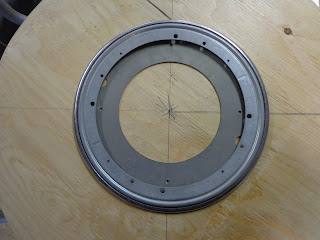It swivels around on a base plate with a lazy susan set up between. The hawk is tethered to the eye bolt on the side and when the bird flies off, or bates, the perch rotates with her. This keeps the leash from being pulled between the tail feathers and possibly causing damage. I imagine the force of the bate will also be turned in to the energy needed to turn the plates and soften the blow. I hope to start with a goshawk,
(another topic for another time,) and therefore needed to increase the scale of the design.
I decided to make the perch 12 inches high as many commercially made bow perches intended for larger hawks were around this height. That meant the diameter would be 24 inches. I bought some oak veneered 3/4" plywood for appearance, strength, and price. I also found the largest lazy susan swivel they had, 12", and set off to make the perch.
I cut it out, then sanded down to final dimensions. I also smoothed and beveled the edges. Then I attached the upright to the base with wood glue and six 4" grabber screws. I added a strip of oak edging to strengthen the joint with more glue and nails. Now I cut out the floor piece from 3/4" plywood, then determined where the center is and added the swivel.
If you look closely you can see a large hole at the 4 o'clock and 10 o'clock positions. Those holes will be drilled out from the bottom. This then allows screws to be put in from the back side of the floor plate to the underside of the perch floor plate. You can see there are three hole sizes in each quarter of the circle. Pick which size you need, screw in one and then the opposing one through the access holes we made, rotate the floor plate 90 degrees and put the other two in. From the top there is visible connection.
Now I am coating the perch with several layers of boiled linseed oil. It should give a very hard and easy to clean surface while bringing out the color of the wood.
I also found out how to bend schedule 40 PVC pipe. I had tried to use a heat gun to put some bend in a pipe, but I couldn't get it to a uniform heat. Recently it dawned on me to try what I do with Kydex. I heated the oven to 350 degrees, and put a 18" piece of pipe on a baking sheet, with one end resting up on the edge. I do this to see when the plastic becomes malleable and bends in the heat. After only two minutes, the pipe became soft and flexible. I put a slight bend in it and then held it against the counter until it held the curve on it's own. I then ran some water through it to cool it the rest of the way. I also learned to keep the pipe away from any heating elements as it can burn and warp.
I'll be using this on top of the perch to give it a good dimension, and then wrap it with astroturf. I'll cut a grove down the middle, heat it up then mold it to the wood.
Here's a picture of my dad as we work on the new trap design.
Here's the final product












No comments:
Post a Comment